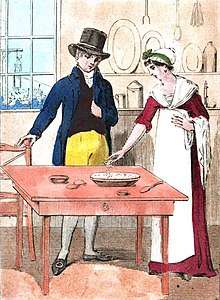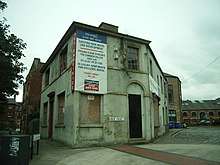Mary Bateman
Mary Bateman (1768 – 20 March 1809) was an English criminal and alleged witch, known as the Yorkshire Witch, who was tried and executed for murder during the early 19th century.
Mary Bateman | |
|---|---|
 Mary Bateman mixing poison | |
| Born | 1768 Asenby, North Yorkshire, England |
| Died | March 20, 1809 (aged 40–41) |
| Cause of death | Hanging |
| Nationality | English |
| Other names | Mary Harker |
| Occupation | Servant Con artist |
| Years active | 1780s-1809 |
| Known for | The so-called 'Yorkshire Witch' |
| Criminal status | Dead |
| Criminal charge | Fraud Murder |
| Penalty | Death by hanging |
| Details | |
| Victims | Rebecca Perigo |
| Imprisoned at | Female Prison, York |
Biography
Mary Bateman was born to a farmer in Asenby, North Yorkshire in 1768.[1] She became a servant girl in Thirsk, North Yorkshire but was eventually released due to petty theft. During the 1780s, she became a minor thief and con artist who often convinced many of her victims she possessed supernatural powers. By the end of the century, she had become a prominent fortuneteller in Leeds who prescribed potions which she claimed would ward off evil spirits as well as acting as medicine.
In 1806 she created the hoax known as The Prophet Hen of Leeds, in which eggs laid by a hen were purported to predict the end times. Villagers believed doomsday had come when a hen began laying eggs with the phrase "Christ is coming" on each one,[2][3] but it was later found to be a hoax perpetrated by Bateman, who had written on the eggs using acid and reinserted them into the hen's oviduct.[4]
She is reported to have once roamed the streets of Leeds after a major fire begging for money and goods for victims, but instead retained the charitable gifts for herself.[5]
Also in 1806, Bateman was approached by William and Rebecca Perigo who believed they had been put under a spell after Rebecca had complained of chest pains and asked for her help in lifting the curse. However, over the next several months, Bateman began feeding them pudding which was laced with poison. While Rebecca regularly ate the pudding, her husband was unable to eat more than a spoonful. Rebecca's condition worsened however and she finally died in May 1806. William Perigo continued to pay her for more than two years until he discovered one of the "charms" which he and his wife had received from Bateman was worthless paper; he went to the authorities who arrested Bateman the following day after William lured her to a meeting.
Although she proclaimed her innocence, a search of her home turned up poison as well as many personal belongings of her victims including the Perigo couple.
Trial and execution
Bateman's trial took place in York in March 1809. The trial lasted eleven hours, though the jury took only a few moments to find her guilty of the charges of fraud and the murder of Rebecca Perigo. Immediately following the sentence of death from the judge, Bateman claimed that she was 22-weeks pregnant and thus unable to be hanged. The judge subsequently requested that the Sherriff gather a panel of 'matrons' to assess Bateman's claim. Twelve married women were sworn into the jury and conducted a physical examination of Bateman, concluding that she was not pregnant and thus able to be executed.[6]
William Knipe's 1867 account suggests that Bateman was married and had a daughter at home as well as an infant child in the prison with her. She supposedly mailed her wedding ring back to her husband to give to the daughter.[6]
She was hanged alongside two men on Monday 20 March 1809.[6] After her execution, her body was put on public display in Leeds and strips of her skin were tanned into leather and sold as magic charms to ward off evil spirits.[5]
Legacy

Bateman's skeleton was on display to the public at the Thackray Medical Museum in Leeds[7] until 2015, when it was returned to Leeds University.[8]
A BBC-TV programme about Bateman, featuring a modern-day descendant of hers (Tracy Whitaker), showed Bateman's skull being laser-scanned to demonstrate how her face may well have appeared. It was first shown on 12 April 2001, entitled The People Detective - 1. Witch and presented by historian and curator Daru Rooke.
References
- Davies, Owen (2004), "Bateman, Mary (1768–1809)", Oxford Dictionary of National Biography, Oxford University Press, retrieved 9 May 2010
- Strandberg, Todd; James, Terry (June 2003). Are You Rapture Ready. New York City: Dutton. pp. 35–45.
- "10 failed doomsday predictions". Retrieved 2009-11-12.
History has countless examples of people who have proclaimed that the return of Jesus Christ is imminent, but perhaps there has never been a stranger messenger than a hen in the English town of Leeds in 1806. It seems that a hen began laying eggs on which the phrase "Christ is coming" was written. As news of this miracle spread, many people became convinced that doomsday was at hand — until a curious local actually watched the hen laying one of the prophetic eggs and discovered someone had hatched a hoax.
- Charles Mackay (1980). Extraordinary popular delusions & the madness of crowds. Random House. ISBN 0-517-88433-X.
- Johnson, Helen (31 October 2018). "The Yorkshire Witches: Mary Bateman, Mary Pannal and Mother Shipton". Yorkshire Post.
- Knipe, William (1867). "Mary Bateman". Criminal chronology of York castle; with a register of criminals capitally convicted and executed at the County assizes, commencing March 1st, 1379, to the present time. pp. 145-149.
- Goor, K. (2006) Haunted Leeds, Tempus, Page 37
- Summer Strevens (2017). The Yorkshire Witch: The Life and Trial of Mary Bateman. Pen and Sword. p. 135.
Further reading
- Baring-Gould, Sabine (1900). . Yorkshire Oddities, Incidents and Strange Events (5 ed.). London: Methuen. pp. 401–424.
External links
- The Newgate Calendar - Mary Bateman
- The Witching Hours: Mary Bateman by Roy Stockdill
- "York Castle prisons - Executions at York". Archived from the original on October 4, 2006. Retrieved February 28, 2007.
- The Case of the Yorkshire Witch